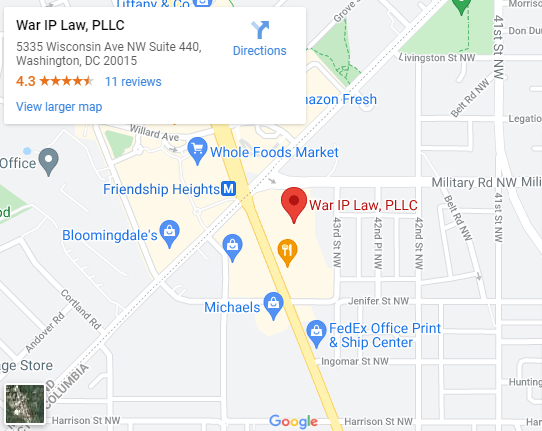According to Q4 2023 data from the United States Patent and Trademark Office (USPTO), about 35% of those who filed applications gained approval upon first action. In other words, these applications led to approvals without any pushback from the USPTO. The remaining 65%, however, likely encountered a range of challenges during the application process. These challenges take the form of “office actions,” official letters from the USPTO informing applicants of various issues. If applicants fail to resolve these issues, the USPTO may reject their applications. While this might seem like the logical conclusion of the application process, an applicant may take several steps even after the trademark application is rejected by the USPTO. To approach this challenge alongside an experienced intellectual property attorney, consider contacting War IP Law PLLC by calling (202) 800-3754.
What Happens After a Trademark Application Is Rejected by the USPTO?
The USPTO will only issue a final rejection for a trademark application after at least one nonfinal office action has been issued. These nonfinal office actions inform applicants of issues for the first time. If an applicant fails to correct or overcome any of the issues in a non-final office action, they may receive a final office action. This represents the last warning from the USPTO, and failure to respond effectively will result in an abandoned trademark application. A trademark application will also be abandoned if the applicant does not timely respond to either the non-final office action or the final office action. While the USPTO does not “reject” trademarks per se, it may “refuse” to register trademarks due to various potential legal problems.
Abandoned Trademarks Explained
According to the USPTO, an abandoned trademark cannot lead to a registration. Note that some applicants choose to intentionally abandon their trademarks, as this may be beneficial in some cases. If an applicant unintentionally fails to respond to a final office action, the applicant may petition to “revive” the abandoned trademark application. This strategy provides a second chance to address legal problems associated with the application—perhaps with newfound guidance from an intellectual property lawyer from War IP Law PLLC.
When To File an Appeal With the Trademark Trial and Appeal Board
After receiving a final office action (and only after), an applicant may file an appeal with the Trademark Trial and Appeal Board (TTAB). This board focuses exclusively on legal disputes that arise regarding trademark registrations. Applicants must file their TTAB appeals within six months of receiving final office actions. If the TTAB rejects an appeal, the applicant may request reconsideration from the board within one month of the decision.
Filing an Appeal With the United States Court of Appeals for the Federal Circuit
Filing an appeal with the United States Court of Appeals for the Federal Circuit is the final option after a trademark application is rejected. This appeals court will examine decisions made by both the USPTO and the TTAB and determine whether either party made an error. In some cases, they may overrule these decisions.
Why Did the USPTO Deny the Trademark Application?
Although it is technically possible to take a rejected trademark all the way to the United States Court of Appeals, a much more obvious tactic is to simply address the legal problem(s) raised by the nonfinal office action. The first step after a nonfinal office action should be to determine the nature of the problem. With a clear understanding of the issue, the applicant can respond effectively. The USPTO states that most of these problems fall into one of a few common categories.
No Definite Identification of Goods or Services
Applicants must describe the goods and services related to the trademark in a clear manner and without jargon. This helps the USPTO identify any potential conflicts with existing trademarks. The office needs this data to put the trademark into the correct category, calculate fees, and run an accurate search within the database.
No Disclaimer for a Portion of the Trademark
In some cases, the USPTO determines that a portion of a trademark is not registrable. However, the applicant may still register the mark after disclaiming the non-registrable portion. Failure to provide this disclaimer may result in refusal.
Specimen Refusal
Applicants must provide specimens with their applications, or in response to a Notice of Allowance, with commonly used examples including flyers, online ads, packaging, etc. Different specimens may be necessary depending on whether the mark represents a “good” or a “service.”
Likelihood of Confusion
If a mark is too similar to an already registered trademark or a mark whose application is pending, and the goods and/or services are similar, the USPTO may refuse registration. The logic is that this similarity may confuse consumers. Therefore, applicants should be sure that their marks are unique before applying.
Descriptiveness Refusal
If the trademark is too descriptive, the USPTO may refuse to register it. For example, a company that manufactures snowboards would likely struggle to register the trademark “Snowboard Company” because the phrase “merely describes” the underlying product.
Commonly Used Phrase Refusal
If the trademark contains a commonly used phrase, the USPTO may reject the application. Examples of common English phrases include “kill two birds with one stone,” “the best of both worlds,” and “a blessing in disguise.” Note that the USPTO also considers phrases commonly associated with religions or high-profile organizations, such as Bible excerpts or military mottos.
Can an Applicant Refile a Trademark Application?
If the initial application to register a trademark is rejected, an effective step may be to file another application. While the first application may remain abandoned, a new application could address the previous issues and still protect the same basic mark. Although applicants may need to make certain adjustments in this second trademark application, the process may be more expedient than appealing to the TTAB (and subsequently to the Court of Appeals). In addition, filing a new application may be much more affordable in terms of both legal costs and filing fees.
Contact an Intellectual Property Lawyer Today
While rejected trademark applications represent serious roadblocks for entrepreneurs and businesses, this issue may be less problematic than they realize. A slight adjustment is often the only barrier to registration. As long as applicants react to office actions quickly and efficiently, delays should be minimal. Even if the pending trademark has issues at its core, the applicant can simply file a different trademark application that stands a better chance of registration. To assess the next steps after nonfinal office actions, final office actions, or abandoned trademarks, consider contacting an experienced intellectual property lawyer with War IP Law PLLC. Call (202) 800-3754 today to schedule a consultation and discuss the most appropriate course of action to take if your trademark application is rejected.






